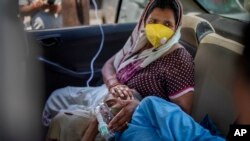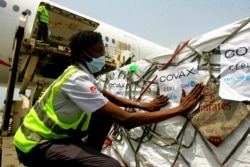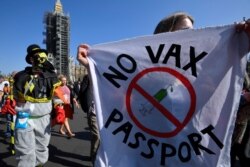The number of COVID-19 jabs administered globally surpassed the 1 billion mark on Saturday, offering hope after months of pandemic misery, even as the number of coronavirus cases worldwide hit another daily record, mainly because of an explosion of the virus in India.
At least 1,002,938,540 doses have been administered in 207 countries and territories, according to an AFP tally.
Nevertheless, the number of new infections topped 893,000 worldwide on Friday, a one-day record.
And India accounted for more than a third of those, with authorities there announcing 346,786 more new cases on Saturday, a record for a single country since the start of the pandemic.
The pandemic has now killed more than 3 million people worldwide since the outbreak emerged in China in December 2019.
And India, with its population of 1.3 billion, has become the new hot spot, with the current surge blamed on a new virus variant and recent "super spreader" public events. The country reported 2,624 new deaths in the past 24 hours.
Transporting oxygen
Overwhelmed by the devastating new surge, the Indian government scrambled to organize special trains to get oxygen supplies to worst-hit cities.
One "oxygen express" carrying 30,000 liters of oxygen arrived in northern Lucknow at dawn on Saturday, where armed guards were waiting to escort trucks to hospitals.
The Indian air force also was being used to transport oxygen tankers and other supplies around the country and to bring oxygen equipment from Singapore.
Thailand was also grappling with a spiraling caseload.
Prime Minister Prayut Chan-O-Cha said Saturday that more than 1,400 COVID-19 patients were waiting to be admitted to hospitals.
"If the outbreak becomes more severe, [the government] may consider reducing hospital quarantine for asymptomatic people from 14 days to 10 days," he said in a move intended to free up hospital beds.
With the pandemic still showing no sign of slowing, governments around the world are placing their hopes in vaccines.
And worldwide, the number of vaccine doses administered has doubled in less than a month.
Nevertheless, while the majority of poor countries have also started to vaccinate — mainly thanks to the COVAX program — inoculation is still largely a privilege of high-income countries. Home to 16 percent of the world's population, they have administered 47 percent of vaccine doses.
By contrast, low-income countries account for just 0.2 percent of shots so far.
In the U.S., regulators have approved the restart of a rollout of Johnson & Johnson vaccines halted over blood-clotting concerns.
Belgium: J&J jabs for all adults
In Europe, Belgium said Saturday that it would authorize the J&J shot for all adults, having already received 36,000 doses and expecting a total of 1.4 million between April and June.
The European Union as a whole said it would have enough vaccines to immunize 70 percent of its adult population by the end of July.
A 91-year-old British grandmother, Margaret Keenan, who on December 8 became the first person in the Western world to get an approved coronavirus vaccine, urged people to get inoculated.
"It really is the best thing I've ever done," she said. "I'm telling everyone to go and get it ... I hope everyone comes forward."
But despite the optimism, the threat of the virus remains ever-present, with Germany implementing tougher new lockdown rules, including night curfews and school closures, after the government passed a disputed new law designed to slow infections.
The controversial new rules — passed this week amid huge protests in Berlin — will apply in all regions with incidence rates of more than 100 new infections per 100,000 people over the last seven days.
And in Britain, ongoing restrictions continued to fuel a great deal of anger.
Huge crowds protested in London on Saturday against Britain's remaining coronavirus restrictions, the mandatory use of masks and the possible introduction of so-called vaccine passports.
Britain began to gradually lift COVID-19 restrictions last month after months of curbs and a successful mass vaccination campaign. Pubs were allowed to serve customers outdoors this month and nonessential shops reopened.
The demonstrators marched along several major arteries, including the main shopping district Oxford Street, with videos and photos showing thousands in attendance.
Hundreds then rallied in Hyde Park late in the afternoon following the march, an AFP reporter said.
Organizers used various websites and online platform pages to encourage turnout, despite curbs that limit outdoor gatherings to 30 people.











